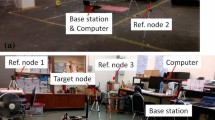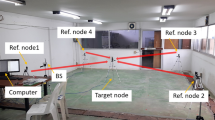Abstract
The received signal strength (RSS) is a common source of information used for estimating the distance between two wireless nodes, whether these nodes are stationary or mobile. Minimum mean squared error distance estimation methods that use the RSS require prior knowledge of both the variance of the noise and, in the case of mobile sensors, the dynamics of the nodes’ mobility. In mobile applications, where low computational complexity is important, pseudo-optimal estimations are preferred, as they do not require such information. In this case, the maximum likelihood estimator (MLE) is often used. In this paper, we propose an efficient pseudo-optimal log-power based distance estimation method using RSS under lognormal shadowing, that improves the MLE. It does not require a priori knowledge either of the movement dynamics or of the variance of the noise. The method is based on adaptively minimizing the variance of the prediction error, using a random walk model with correlated increments. It is analytically demonstrated that the distance estimation error variance of the proposed method improves the MLE in both the static and mobile cases. We use a simulated velocity model example to compare its performance with other algorithms in this group, such as the linear mean square filter and the Gauss–Newton search.







Similar content being viewed by others
References
Gustafsson, F., & Gunnarsson, F. (2005). Mobile positioning using wireless networks: Possibilities and fundamental limitations based on available wireless network measurements. IEEE Signal Processing Magazine, 22(4), 41–53.
Patwari, N., Ash, J., Kyperountas, S., Hero, I., Moses, A. R., & Correal, N. (2005). Locating the nodes cooperative localization in wireless sensor networks. IEEE Signal Processing Magazine, 22(4), 54–69.
Muñoz, D., Bouchereau, F., Vargas, C., & Enriquez-Caldera, R. (2009). Position location techniques and applications. Amsterdam: Elsevier.
Okumura, Y., Ohmori, E., Kawano, T., & Fukuda, K. (1988). Field strength and its variability in VHF and UHF land-mobile radio service. Review of the Electrical Communication Lab, 16, 9–10.
Achutegui, K., Miguez, J., Rodas, J., & Escudero, C. (2012). A multi-model sequential Monte Carlo methodology for indoor tracking: Algorithms and experimental results. Signal Processing, 92, 2594–2613.
Su, Shing-Fong. (2007). The UMTS air-interface in RF engineering. New York: McGraw-Hill.
Chitte, S. D., Dasgupta, S., & Ding, Z. (2009). Distance estimation from received signal strength under log-normal shadowing: Bias and variance. IEEE Signal Processing Letter, 16, 216–218.
Coluccia, A. (2013). Reduced-bias ML-based estimators with low complexity for self-calibrating RSS ranging. IEEE Transaction on Wireless Communication, 12(3), 1220–1230.
Liu, T., Bahl, P., & Chlamtac, I. (1998). Mobility modeling, location tracking, and trajectory prediction in wireless ATM networks. IEEE Journal Selected Areas in Communications, 16, 922–936.
Zaidi, Z. R., & Mark, B. L. (2005). Real-time mobility tracking algorithms for cellular networks based on Kalman filtering. IEEE Transaction on Mobile Computing, 4, 195–208.
Pathirana, P. N., Savkin, A. V., & Jha, S. (2004). Robust extended Kalman filter based technique for location management in PCS networks. Computer Communications, 27, 502–512.
Chiou, Yih-Shyh, Wang, Chin-Liang, & Yeh, Sheng-Cheng. (2010). An adaptive location estimator using tracking algorithms for indoor WLANs. Wireless Networks, 16, 1987–2012.
Black, T.J., Pathirana, P. N., & Nahavandi, S. (2008). Position estimation and tracking of an autonomous mobile sensor using received signal strength. IEEE International Conference on Intelligent Sensors Sensor Networks and Information Processing, Piscataway, N.J (pp. 19–24).
Rong Li, X., & Jilkov, V. P. (2003). Survey of maneuvering target tracking. Part I: Dynamic models. IEEE Transactions on Aerospace and Electronic Systems, 39, 1342–1364.
Myers, K. A., & Tapley, B. D. (1976). Adaptive sequential estimation with unknown noise statistics. IEEE Transaction on Automatic Control, 21, 520–523.
Zhu, Y. M. (1999). Efficient recursive state estimator for dynamic systems without knowledge of noise covariances. IEEE Transactions on Aerospace and Electronic Systtems, 35, 102–114.
Mao, G., Fidan, B., & Anderson, B. D. O. (2007). Wireless sensor network localisation techniques. Computer Networks, 51, 2529–2553.
Feng, R. J., Guo, X. L., Wan, J. W., Wu, Y. F., & Yu, N. (2012). Multihop localisation with distance estimation bias for 3D wireless sensor networks. Electronics letters, 48, 884–886.
Milocco, R. H., Costantini, H., & Boumerdassi, S. (2014). Improved geographic routing in sensor networks subjected to localization errors. Ad Hoc Networks, 13, 476–486.
Milocco, R., & Boumerdassi, S. (2010). Estimation and prediction for tracking trajectories in cellular networks using the recursive prediction error method. In 2010 IEEE International Symposium on a World of Wireless Mobile and Multimedia Networks (WoWMoM), pp. 1–7. doi:10.1109/WOWMOM.2010.5534918.
Mao, G., Anderson, B. D. O., & Fidan, B. (2007). Path loss exponent estimation for wireless sensor network localization. Computer Networks, 51, 2467–2483.
Ramirez Diniz, P. S. (2002). Adaptive filtering: Algorithms and practical implementation (2nd ed.). USA: Kluwer Academic Publishers.
Ljung, L., & Söderström, T. (1983). Theory and practice of recursive identification. Cambridge: MIT Press.
Tichavsky, P., Muravchik, C., & Nehorai, A. (1998). Posterior Cramer–Rao bounds for discrete-time nonlinear filtering. IEEE Transactions Signal Processing, 46, 1386–1396.
Papoulis, A. (1965). Probability, Random Variables and Stochastic Process. New York: McGraw-Hills.
Greenberg, H. J., & Pierskalla, W. P. (1971). A review of quasi-convex functions. Operations Research, 19, 1553–1570.
Acknowledgments
This work was supported by the Consejo Nacional de Investigaciones Científicas y Técnicas (CONICET), Agencia Nacional de Promoción Científica y Técnica, Universidad Nacional del Comahue, Argentina, and the Centre d’Etude et de Recherche en Informatique du CNAM, France.
Author information
Authors and Affiliations
Corresponding author
Appendix
Appendix
We first show that there is a unique minimizer of \(\sigma ^{2}_\epsilon\) in the interval \(\theta (k)\in [0,1]\) for the family of movement dynamics whose autocorrelation can be represented by a Fourier series expansion. Various motion dynamic cases can be represented using this representation, ([14]). By using (26), the prediction error at step \(k+1\) can be represented by the following recursion:
where \(r(k)\) is a zero mean, incremental log-power sequence given by
By taking the expected value of \(\epsilon ^2(k)\) and considering that \(\eta (k)\) is an \(i.i.d.\) sequence, independent of \(r(k)\), we obtain the following relationship for the prediction error variance:
where \({\mathcal {E}}[\eta (k+1)\epsilon (k)]=0\). The expectations of the last two terms are given by
where \(R(i)={\mathcal {E}}[r(k)r(k-i)]\). By using it in (43) and taking into account that \(\sigma _r^2=R(0)\), the final expression of \(\sigma _\epsilon ^2\) is obtained as
In order to analyze the possible minimizers of cost function \(\sigma _\epsilon ^2\) with respect to \(\theta\), we need to write the correlation function \(R(i)/\sigma _r^2\). To this end, let us consider the following complex series expansion representing the autocorrelation:
where \(\alpha _n\) is complex with \(|\alpha _n|\le 1\), \((*)\) means compex conjugate, and \(R(i)\) is a positive definite function, [25]. Thus, the last term in the numerator of (46) gives
By denoting \(\alpha _n=\rho _n e^{j\varphi _n}\) and taking into account that both \(\theta\) and \(\rho _n\) are positive and less than one, a family of possible values for each element of the sum are given by the following parametrization:
where \(\rho _n\in [0, 1]\) and \(\varphi _n\in [0, 2\pi ]\). Now, we need the following lemma:
Lemma
[26]: Let \(g\) and \(f\) be defined on a convex set \(\varTheta\), such that \(f(\theta ) \ne 0\) for all \(\theta \in \varTheta\). Then, \(g/f\) has only one minimum on \(\varTheta\) (quasi-convex) if both \(f(\theta )> 0\) is concave and \(g(\theta )\ge 0\) is convex for all \(\theta \in \varTheta\).
First, from (46) and (49), we can write
From (51), \(f(\theta )>0\) concave, for \(\theta \in (0, 1)\), and from (50), \(g(\theta )\) is always positive definite. In order to study its convexity we obtain the second derivative with respect to \(\theta\) which gives
By calculating derivatives we find that the minimum of the above is given at \(\theta \rho _n=0\) for any possible value of \(\cos (\varphi _n)\). Then, for \(\cos (\varphi _n)\ge \sqrt{1/2}\), the second derivative is always positive, which restricts the value of \(\varphi _n\) in the interval [\(-\pi /4, \pi /4\)]. This means that the higher-frequency sinusoidal component of the Fourier Series Expansion of \(R(i)\), (47), must contain at least eight samples per period, which is a weak restriction. Thus, we can conclude that, under mild assuptions, there exists only one minimizer for the minimum variance prediction error for \(\theta\), within the interval (\(0, 1\)).
In order to prove (iii), let us compute the upper bound of \(\sigma _\epsilon ^2\). By taking into account that \(R(i)/\sigma _r^2\) is an autocorrelation function, from (46) the following inequality holds:
Now, let us define the minimizer of \(h(\theta )\) as
By multiplying both sides of (54) by \(1-\theta ^2\), within the admissible interval of \(\theta\), and performing the derivative, with respect to \(\theta\), the following upper bound for the minimum of \(\sigma _{\epsilon }^2\) is obtained:
In order to find the relationship between the variance of \(e(k)\) and the variance of the prediction error, we use (22) as follows:
where the last term of (58) is \({\mathcal {E}}[\eta (k)\epsilon (k)]=\sigma _\eta ^2\). Finally, by replacing the bound (56) in (59) we obtain an upper bound on the pseudo-optimal minimum error attainable for any correlation function as follows:
In particular, in the static case, \(\sigma _r^2=0\), the minimizer is \(\bar{\theta }=1\), which leads to \(\sigma _{\epsilon min}^2=\sigma _\eta ^2\) and \(\sigma _e^2=0\).
Rights and permissions
About this article
Cite this article
Milocco, R.H., Boumerdassi, S. An efficient adaptive method for estimating the distance between mobile sensors. Wireless Netw 21, 2519–2529 (2015). https://doi.org/10.1007/s11276-015-0930-3
Published:
Issue Date:
DOI: https://doi.org/10.1007/s11276-015-0930-3




